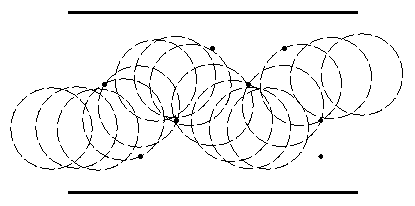Not an official ACM page
[Problem E
| 1994 Western European Regional problem set
| My ACM problem archive
| my home page]
1994-1995 ACM International Collegiate Programming Contest
Western European Regional
Problem E
Fatman
Some of us may be so fortunate to be thin enough to squeeze through
the tiniest hole, others are not. Getting from A to B in a crowded
supermarket (even without a cart) can be tough and may require
sophisticated navigation: there may seem to be enough room on the one
side, but then you may run into trouble with that lady further
down...
Let's consider this in an abstract fashion: given an aisle of a
certain width, with infinitely small obstacles scattered around, just
how fat can a person be and still be able to get from the left side to
the right side. Assume that seen from above a (fat) person looks like
a circle and the person is incompressible (a person with diameter d
cannot go between two obstacles having distance less than d).
Input
The first line of input specifies the number of test cases your
program has to process. The input for each test case consists of the
following lines:
- One line with the integer length L (0 <= L
<= 100) and integer width W (0 <= W <= 100)
of the aisle, separated by a single space.
- One line with the number of obstacles N (0 <=
N <= 100) in the aisle.
- N lines, one for each obstacle, with its integer
coordinates X and Y (0 <= X <=
L, 0 <= Y <= W) separated by
a single space.
Output
For each test case given in the input, print a line saying
'Maximum size in test case N is M.', where
M is rounded to the nearest fractional part of exactly four
digits. M is the maximum diameter of a person that can get
through the aisle specified for that test case. N is the
current test case number, starting at one.
Sample Input
1
8 5
8
2 1
1 3
3 2
4 4
5 3
6 4
7 2
7 1
Sample Output
Maximum size in test case 1 is 2.2361.
The sample input looks like:

This page maintained by
Ed Karrels.
Last updated September 20, 1999

